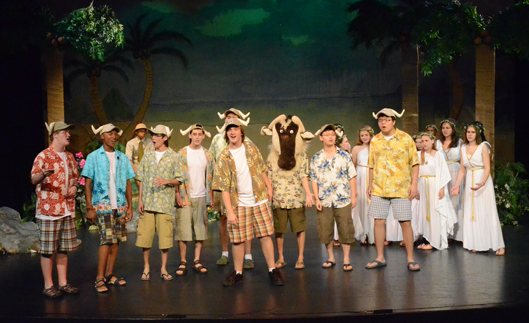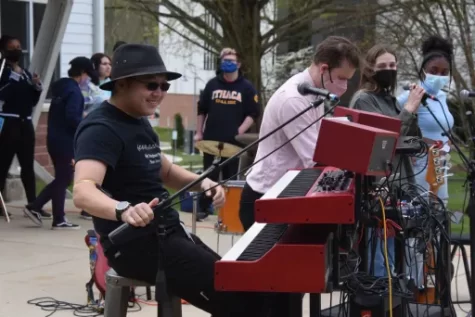Stampede in the Light

February 12, 2020
For those of you who are unfamiliar with the Sandy Spring Friends School community, you wouldn’t know that the school’s mascot is a wildebeest. Yes, like the ones from the savanna, who are a mix between cows and horses. So why, you may ask, did the school make the decision to be represented by such a …unique animal? Well, maybe it was the fact that at school sports events and games we can call ourselves the “beests”. This ferocious name intimidates opponents at first, but disguises the underlying and more mild identity of wildebeests. Another reason this interesting creature was selected to be the face of the school could have been because wildebeests actually embody all of the Quaker SPICES: simplicity, peace, integrity, community, equality, and stewardship.
Clearly wildebeests are masters of simplicity. For one, they wear no clothes. Although this dress code would not be acceptable for our school, it is the most simple way of dressing. Perhaps a fanatic Quaker might take up this practice and live in the same ways that this large pack animal does. And what about grooming? There is another parallel between these animals and Quakers. Although these creatures do not wear leather breeches, they do have shaggy, shaggy locks just like George Fox. If that is not an example to live up to, then I don’t know what is.
Wildebeests are also peaceful animals. They mind their own business while grazing and feeding with the rest of the herd. These animals have a completely vegetarian diet. They don’t harm any other animals and believe in nonviolence. This peaceful nature helps maintain the harmony of the savanna where they reside. Very Quaker.
Integrity is also a trait that is carried through the lives of wildebeests. Their integrity and similarities to Quaker worship can be represented in their quiet and reflective nature. They communicate with one another, rarely vocalizing their thoughts, but rising out of the silence. Usually during the heat of the day, they mostly stay stationary with little noise. In the midst of all the chaos and all the creatures surrounding them, they remain quiet. This is a quality that all of the upper school advisors wish their students would demonstrate. Instead, our silence is frequently broken with the sneezing or snoring of our students.
Perhaps the most significant “spice” that the wildebeest embodies is community. These animals always travel in packs. Their stampedes are fierce and can be deadly even for predators such as lions (cue Mufasa’s death scene). These large stampedes quake the earth in the same way that George Fox quaked when he heard God within himself. Community is very important to wildebeests because there is safety in numbers. They protect one another and pull each other out of the jaws of death. When drinking from rivers such as the Nile, they are often attacked by vicious crocodiles who will not attack if there is a large group of wildebeests. The most important takeaway from the concept of community is that wildebeests are proof that we are all truly part of a solid Quaker community. If a bunch of cows can run around and make the ground shake, then there is a lot more we can do if we all out our minds to it.
Do we really have equality among the different classes at SSFS? Well, neither do wildebeests. I mean we’ve all heard the term “senior privilege” and know that the lower classmen are the ones running from class to class and dropping their books in Moore Hall. The upperclassmen have their territories such as the lounge or one of the rooms in the library. In a similar fashion, the wildebeests are lacking in their equality. They are very territorial and have a social hierarchy of who guards what areas. There are often competitions amongst them where the different rankings within the herd will go head to head. We do this at school as well, in a friendly Quaker competition we like to call the Sophomore Olympics. The wildebeests do, however, maintain equal status with other species such as zebras and gazelles who also travel in packs and herds. The wildebeests have diversity within each herd in that some are stationary and some are nomadic. When applying to school/a herd, this is one of the selling points that many parents want for their children. They would like for them to learn in a diverse environment filled with a multiplicity of personalities, and nomadic species.
These herd animals are also great stewards to the earth. Their stampedes cultivate the land they travel on. This renews the soil and helps with plant growth. They also help other species and are efficient to dung beetles in specific. These beetles collect tons of feces that the wildebeests create when they travel in herds. They actually help the bugs by giving them opportunities to get community service hours. These beetles have the wildebeests to thank when their transcripts finally say 100 hours completed. In fact, we could really take notes on some of the things these wildebeests do for the earth. I mentioned before that they are herbivores. Do you know what this means for their carbon hoof print?! I mean forget meatless Mondays, wildebeests are saving the earth one meal at a time. Imagine a world where every meal was “simple meal”.
I hope I could shed some light on these wild beasts and how they embody the SPICES that we all strive for within our own lives. And on a more important note, I hope I eliminated any questions regarding why our school has this iconic creature as our mascot. These animals let their lives speak and live by example. We must learn to walk in the light just like these gentle cows do everyday as they traverse the savanna.
Sources
https://animalcorner.co.uk/animals/wildebeest/
https://www.nationalgeographic.com/animals/mammals/b/blue-wildebeest/
https://www.woburnsafari.co.uk/discover/meet-the-animals/mammals/brindled-wildebeest/






aditya gedam • Feb 21, 2020 at 10:25 am
It is one the best attempt to give wonderful lessons and learning through nature which created by the supreme being (GOD) …your writing has inside with our Indian spiritual literature which also the core heart of learning for the distracted and misdirected human being in the age of sin and misfortune. we are more responsible for our own destruction than the creator himself. sensitivity to the other is the essential and core attributes of the human being but today the unfortunate situation is that we all lack in little or more in a way in that manner. A lady from India who was sold by father in a marriage and then exploited by her husband miserably throughout, to the point of killing her . during her such trouble a simple cow from the shed becomes the savior, where she was thrown out after hours beating by husband and mother in law, saves her life . in that crowded shed a simple cow comes and feed her whole week and helps her to escape her from the shade, during her trouble she was pregnat and she was about to deliver a baby . in the uncounsious state she does so deliver and the simple cow feeds her baby and saves her from crowded cow shed . before leaving the cow shed she promises I will too save the valuable lives of the people till my last breath and actually she is doing so now and then her daughter who was born on that condition of life is also now assisting her to run many orphanages where unsheltered people seak the shelter. she was helpless but now she is a mother of many and her daughter who is a doctor also now becoming the mother of many by helping them to live a better way of life. the great modern Indian saint and spiritual teacher A.C.bhaktivedant swami says there is tremendous need to revive the inner consciousness of the humanity to understand our true nature which is lost in the age of science and modernity.it is very essential to increase our compassion and sensitivity towards each other and towards mother nature and her loving children .to conclude this I remember a very famous statement from rechard Slavin sir ” when our roots are deepened to the original source of nourishment, the natural fulfilment of all the living being automatically happens which is beyond our perception. thank you for your wonderful sharing Ms Revati.